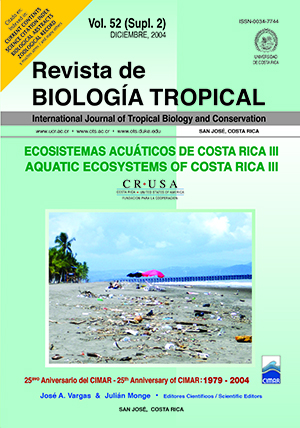Resumen
Un total de 29 muestras de sedimentos recolectadas de 1996 a 2002 en el Golfo Dulce, Costa Rica fueron analizadas determinar las concentraciones de bifenilos policlorinados (PCBs). La Bahía de Rincón y el Río Esquinas en la parte noroeste del Golfo tienen concentraciones relativamente bajas de PCBs, con ninguna muestras superando los 2.1 ug/ dw (peso seco) de sedimento. El puerto de Golfito tuvo las mayores concentraciones hasta un máximo de 15.7 ug/g dw de sedimento. Estas muestras también estuvieron dominadas por los congéneres más clorinados. Las muestras de los sedimentos profundos (>100 m ) de las aguas de la parte norte del Golfo, así como las de la estela del Río Coto Colorado, tienen concentraciones intermedias. Dentro de la estela de sedimentos del Río Colorado las concentraciones aumentaron con la profundidad y los congéneres variaron con la profundidad hacia los menos clorinados. Sin embargo, la región profunda tuvo una de las más altas concentraciones de PCBs, pero la tendencia hacia los menos clorinados no fue aparente o significativa. No se conoce si las condiciones anóxicas en las aguas profundas son capaces de iniciar la declorización. En general, las muestras analizadas muestran concentraciones moderadas de PCBs, no obstante las condiciones pristinas del Golfo y su cuenca.Citas
Dalsgaard, T., D.E. Canfield, J. Petersen, B. Thamdrup, J. Acuña-González. 2003: N2 production by the anammox reaction in the anoxic water column of Golfo Dulce, Costa Rica. Nature 422: 606-608.
Eisenreich, S.J., B.B. Looney & J.D. Thornton. 1981: Airborne organic contaminants in the Great Lakes ecosystem. Env. Sci. and Technol. 15: 30-38.
Erickson, M.D. 1997: Analytical Chemistry of PCBs, 2nd Edition. Lewis Publishers, NY. 667 p.
Hebbeln, D., D. Ceese & J. Cortés. 1996: Morphology and sediment structures in Golfo Dulce, Costa Rica. Rev. Biol. Trop. 44: 1-10.
Kuever, J., C. Wawer & R. Lillebæk. 1996: Microbiological observations in the anoxic basin Golfo Dulce, Costa Rica. Rev. Biol. Trop. 11: 49-57.
Murphy, T.J., L.J. Formanski, B. Brownawell & J.A. Meyer. 1985: Polychlorinated biphenyl emissions to the atmosphere in the Great Lakes Region: municipal landfills and incinerators. Env. Sci. and Technol. 19: 942-946.
Richards, F.A., J.J. Anderson & J.D. Cline. 1971: Chemical and physical observations in Golfo Dulce, an anoxic basin on the Pacific coast of Costa Rica. Limnol. Oceanogr. 16: 43-50.
Spongberg, A.L. 2004: PCB Contamination in Surface Sediments in the Coastal Waters of Costa Rica. Rev. Biol. Trop. 52 (Supl. 3A): 1-10.
Spongberg, A.L. & P. Davis. 1999: Preliminary investigation of pesticide contamination in Golfo Dulce, Costa Rica. Rev. Biol. Trop. 46 (Suppl. 5): 111-124.
Thamdrup, B., D.E. Canfield, T.G. Ferdelman, R.N. Glud & J.K. Gundersen. 1996: A biogeochemical survey of the anoxic basin Golfo Dulce, Costa Rica. Rev. Biol. Trop. 44: 19-33.
United States Environmental Protection Agency. 1992: Test methods for evaluating solid waste: physical/chemical methods. Method 8081: Organochlorine pesticides, halowaxes and PCBs as Arochlors by gas chromatography: Capillary Column Technique.
Vanier, C., M. Sylvestre, & D. Planas. 1996: Persistence and fate of PCBs in sediments of the Saint Lawrence River. The Science of the Total Environment 192: 229-244.
##plugins.facebook.comentarios##

Esta obra está bajo una licencia internacional Creative Commons Atribución 4.0.
Derechos de autor 2004 Revista de Biología Tropical


